Pruning Bamboos & Grasses
"Bamboo taming tools"
We planted our bamboos in 2004 and by using these tools and a garden fork, we have to date managed to successfully prevent our bamboos clumps from becoming invasive or too overgrown.
We advise other people to use a bamboo root barrier however, to date we have not used any root barrier ourselves. We prefer in our own physical way to removing any excessive or invasive root growth by the use of these tools.
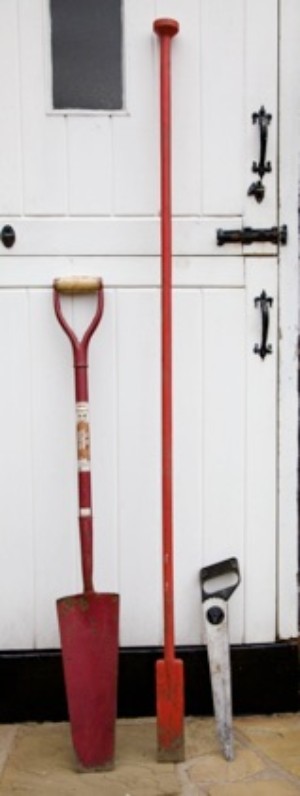
MORE DETAIL OF THE TOOLS:
Post Hole Digger (the brand we used was "Faithfull Post Hole Bar - Chisel End 7.7kg 1.75M")
Features:
Length 69in / 1750mm.
Bar diameter 1in / 25mm.
Weight 17lb.
Steel post hole digging bar manufactured from high grade heat treated steel bar with one chisel point and one tamper head. The post hole digger has a 2 3/8inch mushroom head at one end and a 2 1/2inch bevelled chisel edge at the other.
After dividing the bamboo clump using the weight and cutting power of a post hole digger, a long bladed drain spade is useful for cutting the minor roots in order to finally allow release of the divided section of the bamboo clump for removal and for replanting elsewhere.
Drain spade features:
The long narrow blade makes it suitable for reaching deeper than a normal spade and for cutting minor roots.
The brand we used was "Faithfull 5NDAM All Steel Shovel"

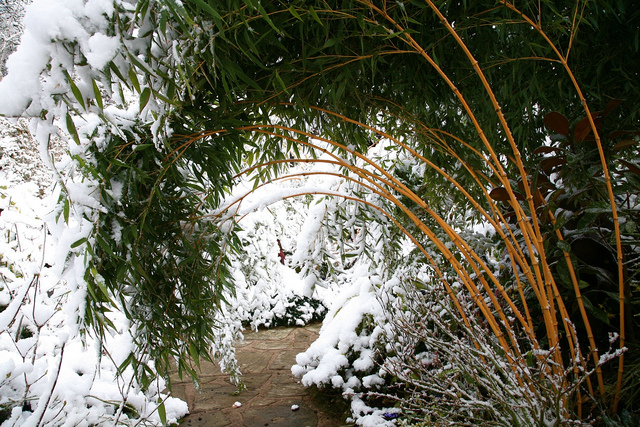
Essentially we meet bamboo force with our force!!
Every 12 -18 months we check around all our bamboos by probing with a garden fork or one of these tools. We track down and remove any rhizome runner and we use the tools to remove sections of bamboo clumps when necessary in order to keep the clumps to a visually pleasing size.
With the right tools it is relatively easy to divide (split up) bamboos if they are getting too large or deal with if the occasional 'runner' that needs to be removed. The horticultural term 'Division' refers to a newly dug section of rhizome that contains one or more culms. At 'Four Seasons' most of the divisions we make will have have at least four culms.
We found the key tool was the tall one in the middle - this tool is very heavy and is really designed for breaking through hard ground, including concrete, in order to make a narrow, deep enough hole such as for a fence post .........essentially it is like a long heavy iron crowbar with a chisel cutting edge at the lower end. This one weighs 7.5kg (17lbs)
The other tools are a tree spade / drain spade and a small saw; however, as we have said, most of the work is done by the heavy tool in the middle of the picture (the Post Hole Digger Bar)
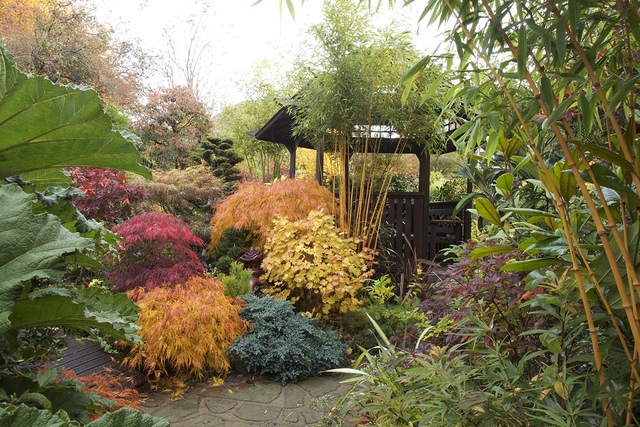
We are not aware of anyone else using the heavy tool for bamboo but it has made a huge difference to our control and confidence in keeping control of the lateral growth of our bamboo clumps! It certainly very useful for splitting up bamboo clumps to make new plants. Using this method, the removed sections of the rhizomes tended to be intact mini clumps with their retained original soil rather the multiple separated fragments of rhizome resulting from an exhausting, prolonged attack with normal tools such as the ordinary garden fork and spade!
We found the technique relatively easy.........but obviously for safety reasons feet are kept well to each side as the bar is lifted....... then, although holding on to the bar, mainly let gravity do the work as the bar 'falls'. However I usually give it just a little extra propulsion as it 'falling'! At some point after a few strikes have been made along the chosen line within the clump, and the chisel end is beginning to get some penetration and separation within the clump, slight leverage of the bar can be tried to each side to force further separation within the clump before giving further strikes .........and finally finishing off any smaller deeper roots with the long drain spade!
I keep that particular shaped saw as a standby to occasionally use and cut through a rhizome. I do not have the name of the brand of the saw in the photo however, there are various brands that would do the same job. The main features of the small saw is that the blade narrows to allow access to be gained to small spaces, it is short and it is relatively fine toothed. The saw should be and strong enough not to buckle ......but not a precious, expensive saw that could be wrecked if I make contact with stones in the ground! In the last couple of years I have found that the heavy post hole digger does most of the necessary below ground level 'cutting' of the bamboo rhizomes.

(1) The tools we use to divide up our bamboos into new plants
At 'Four Seasons' most of the divisions we make will have have at least four culms.
We found the key tool is the 'Post Hole Digger' which is very heavy and is really designed for breaking through hard ground including concrete in order to make a narrow, deep enough hole such as for a fence post .........essentially it is like a long heavy iron crowbar with a chisel cutting edge at the lower end. This one weighs 7.5kg (17lbs)
The other tools are a tree spade / drain spade which has a long blade, a sledge hammer head or lump hammer and a small saw.
However, as we have said, most of the work is done by the heavy tool in the middle of the picture (the Post Hole Digger Bar).

(2) Clump forming bamboo before division

(3) Dividing a clump forming bamboo into new plants
We found the technique relatively easy.........but obviously for safety reasons feet are kept well to each side as the bar is lifted....... then, although holding on to the bar, mainly let gravity do the work as the bar 'falls'. However I usually give it just a little extra propulsion as it 'falling'!
At some point after a few strikes have been made along the chosen line within the clump, and the chisel end is beginning to get some penetration and separation within the clump, slight leverage of the bar can be tried to each side to force further separation within the clump before giving further strikes

(4) Dividing a clump forming bamboo into new plants
We cut through any smaller deeper roots with the long drain spade. If there is any significant resistance we use the weight of the sledge hammer head on the shoulder of the blade of the drain spade. Sometimes we also use a small hand saw to cut through deeper roots.

(5) Dividing a clump forming bamboo into new plants

(6)Dividing a clump forming bamboo into new plants
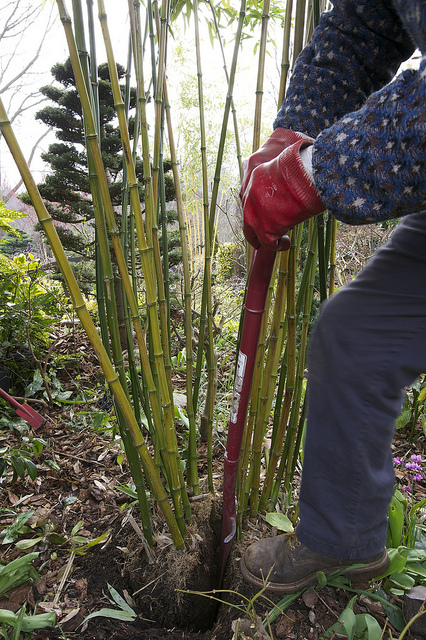
(7) Dividing a clump forming bamboo into new plants
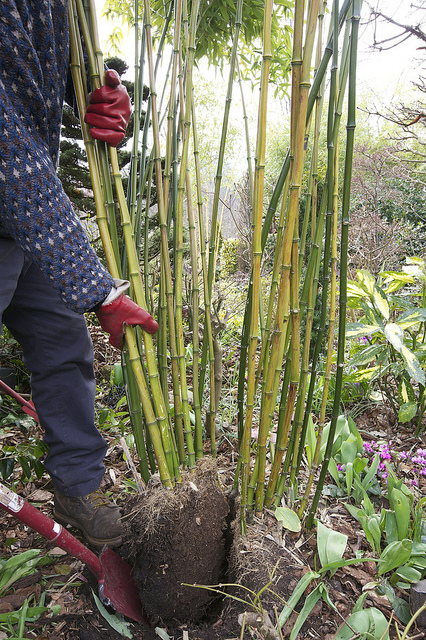
(8) Removing the first bamboo division
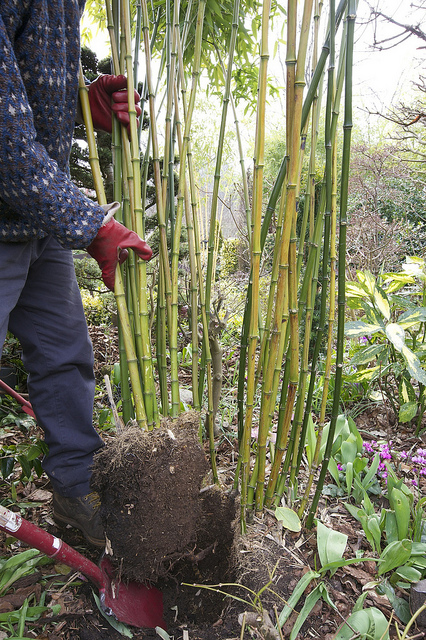
(9)Removing the first bamboo division
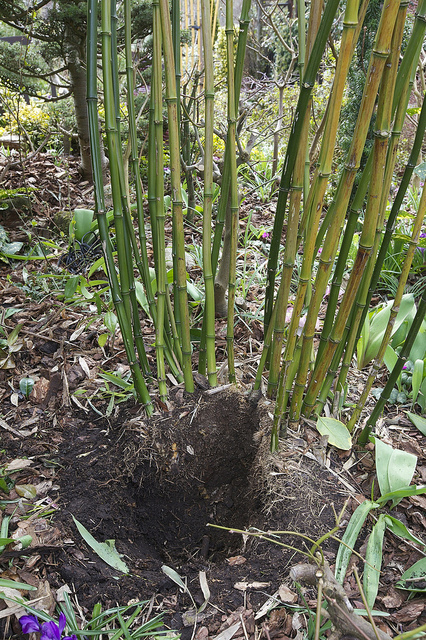
(10)After removal of the first bamboo division
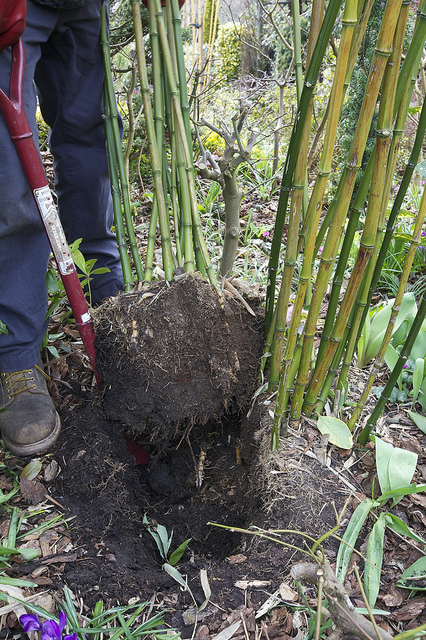
(11) Removing the second division
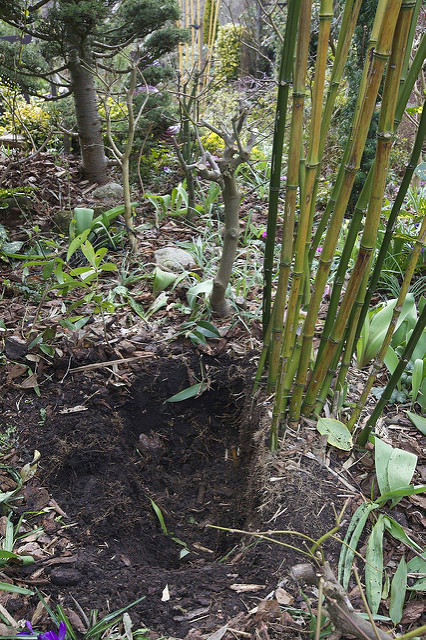
(12) Dividing a clump forming bamboo into new plants
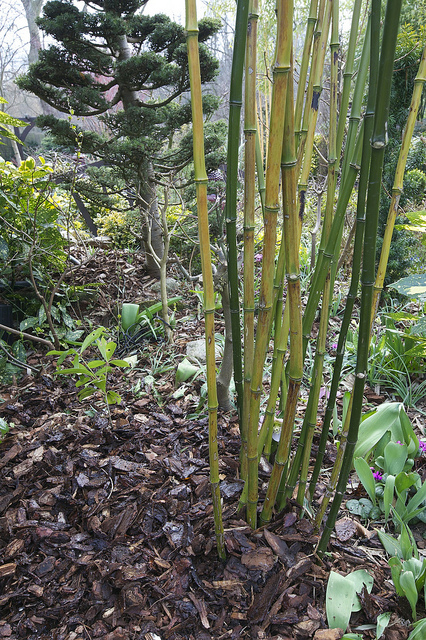
(13) Bamboo clump successfully reduced in size
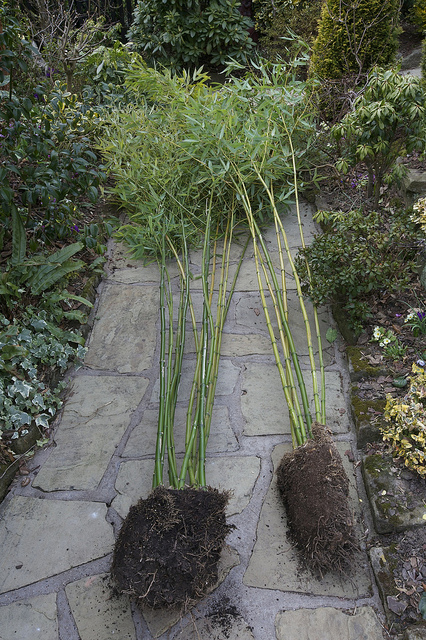
(14) The two removed divisions of the bamboo clump for planting in a new location
Our tools have enabled us to split up bamboo clumps to make new plants. Using this method, the removed sections of the rhizomes tend to be intact mini clumps with their retained original soil rather the multiple separated fragments of rhizome resulting from an exhausting, prolonged attack with normal tools such as the ordinary garden fork and spade!
We are not aware of anyone else using the heavy tools we use for dividing off new bamboo plants and for general control of the growth of our bamboo clumps.
By making large divisions we have also made many new bamboo plants for our garden and also for friends and other gardeners who have been keen to own bamboo plants. However, we have always advised all of them to use a root barrier even if we don't!
Four Seasons Sitemap
© All Rights Reserved
Please do not download our photo images from this website to use for publication or any commercial reason without our permission.
Images may not be copied, reproduced, published or distributed in any medium without the expressed written permission of the copyright holder.
